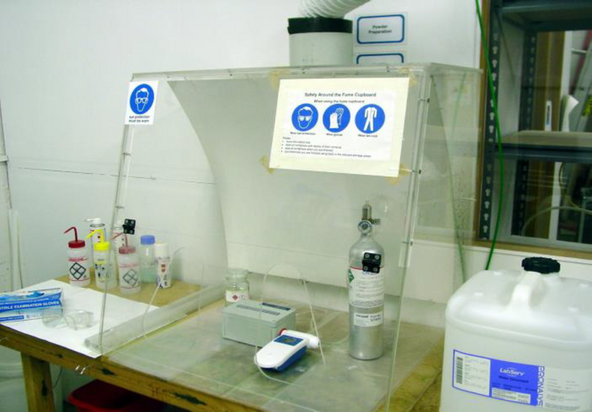Upmost care must be taken while performing a zero or span calibration. Cylinder gas can cause harm in a number of ways. There a number of sources of good information about the correct use and storage of compressed gases. The following information is a guide for what to consider when handling compressed gas but Aeroqual recommends operators adhere to their local regulations regarding compressed gas handling.
The following resources may prove useful:
High pressure leak or failure of pressure regulator
Many calibration gases are held in cylinders at high pressure in excess of 1000 PSI. Incorrectly fitting the pressure regulator, using a regulator which is faulty or knocking the cylinder over while the regulator is attached can cause physical harm from high speed projectiles resulting from a high pressure leak from or failure of the regulator.
It’s important to fit a high-quality undamaged pressure regulator to the gas cylinder and to make sure the regulator type is suitable for the cylinder you are attaching it to.
Important: Always use safety glasses when working with compressed gas.
Flammability of combustible gases
Calibration gas can be stored in cylinders at high concentrations and this can present a hazard if those gases are combustible. The lower explosive limit (LEL) is the lowest concentration of gas at which combustion will be sustained in air if an ignition source (spark or flame) is present. The LELs for the gases used for calibrating Aeroqual sensor heads are all significantly above the calibration span points so this risk is low. It’s important however that the LEL be known for the gas being employed and that suitable precautions be taken to further minimize the risk from explosive combustion such as performing the calibration in a fume hood.
Refer to the table below with LELs for the gases used to calibrate Aeroqual’s sensor heads.
Toxicity
While most of the recommend span points fall below the Immediately Dangerous to Life or Health (IDLH) limits published by the National Institute for Occupational Health and Safety (NIOSH), some span points are above these limits and therefore it’s crucial that rigorous health and safety procedures be followed during calibration to avoid exposure to the calibration gas.
Refer to the table below for IDLH concentration limits as well as concentration limits for longer exposure times for the gases used to calibrate Aeroqual’s sensor heads.
The LDLH limits are known for most of the gases of concern, however there are some gases for which data are not available. In these cases, gases should be considered as being toxic and handled as such. Health and safety data are often revised. Aeroqual recommends checking external sources for the most up-to-date information. Aeroqual suggests that all span calibrations be performed in a fume hood such as the one in the image below to avoid exposure to personal.

IDLH concentration limits
The information below is an indication only. Please check for the latest information or local guidelines as values may vary by jurisdiction.
| Gas | IDLH (ppm) | PEL (ppm) | STEL (ppm) | LEL (ppm) |
|---|---|---|---|---|
| Carbon monoxide | 1200 | 25 | N/A | 125,000 |
| Carbon dioxide | 40,000 | 5000 | 30000 | N/A |
| Nitrogen dioxide | 20 | N/A | 1 | N/A |
| Ammonia | 300 | 25 | 35 | 150,000 |
| Hydrogen | N/A | N/A | N/A | 40,000 |
| Hydrogen sulfide | 100 | 10 | 15 | 40,000 |
| Methane | N/A | N/A | N/A | 50,000 |
| Ozone | 5 | 0.1 | 0.3 | N/A |
| Perchloroethylene | 150 | N/A | N/A | N/A |
| Sulfur dioxide | 100 | 2 | 5 | N/A |
| Isobutylene | N/A | N/A | N/A | 18,000 |
IDLH = Immediately dangerous to life or health
PEL = Permissible exposure limit (usually based upon a time weighted 8-hour average
STEL = Short-term exposure limit (1-hour average)
LEL = Lower explosion limit

